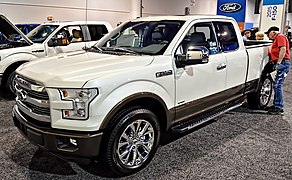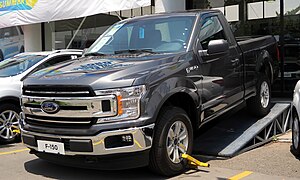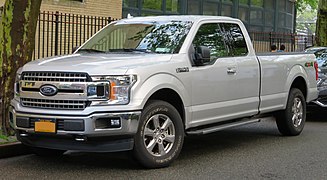Ford F-Series (thirteenth generation)
| Thirteenth-generation Ford F-Series (P552) | |
|---|---|
 | |
| Overview | |
| Manufacturer | Ford Motor Company |
| Also called | Ford Lobo (Mexico) Sutton CS 3000 (Malaysia, regular) Sutton CS 3500 (Malaysia, Raptor) |
| Production | November 11, 2014[1]–September 2020 (Dearborn)[2] |
| Model years | 2015–2020 |
| Assembly |
|
| Designer |
|
| Body and chassis | |
| Class | Full-size pickup truck |
| Body style |
|
| Layout |
|
| Platform | Ford T platform (T3) |
| Related | Ford Atlas concept Ford Super Duty (P558) Ford Raptor (from 2017) |
| Powertrain | |
| Engine |
|
| Transmission | 6-speed Ford 6R80 automatic 10-speed Ford 10R80 automatic |
| Dimensions | |
| Wheelbase |
|
| Length |
|
| Width | 79.9 in (2,029 mm) |
| Height | 75.2–76.9 in (1,910–1,953 mm)[4] |
| Curb weight | F-150:
|
| Chronology | |
| Predecessor |
|
| Successor | Ford F-Series fourteenth generation (MY 2021-present) |
The thirteenth-generation Ford F-Series is a range of pickup trucks produced by Ford. Introduced for the 2015 model year, this generation of the F-Series is the first aluminum-intensive vehicle produced on a large scale by an American vehicle manufacturer. For the 2017 model year, the fourth-generation Super Duty line adopted the cab design of the F-150, consolidating the cab design for the first time on Ford light-duty trucks (F-550 and below) for the first time since the 1996 model year; the Super Duty trucks still retain separate bodywork and a higher-GVWR frame.
After a two-year hiatus, a second generation of the Ford Raptor made its return for 2017 as a high-performance variant of the F-150, dropping the SVT prefix). In Mexico, the F-Series XL trim is marketed as the F-150, XLT and higher trims are named Lobo (Wolf in Spanish).[6] The Mexican-market Lincoln Mark LT was discontinued completely, replaced by the Limited and Platinum trims sold elsewhere.
The thirteenth-generation F-Series is produced by Ford in Claycomo, Missouri (Kansas City Assembly) alongside the Ford Transit van and at Dearborn, Michigan (Dearborn Truck Plant).
Design overview[]

The thirteenth-generation F-Series was unveiled at the 2014 North American International Auto Show on January 13, 2014.[7] A number of safety technologies and driver assistance features were introduced as options, including: 360° camera, adaptive cruise control, collision warning with brake support, blind spot information system (BLIS) with cross-traffic alert, and a lane-keeping system.
While not the first aluminum-bodied vehicle developed by Ford (the company developed 40 aluminum-bodied Mercury Sable prototypes in 1993, reducing curb weight by 400 pounds[8]), the F-Series was the first Ford aluminum-bodied vehicle to make it to production.[8] While changing the metal composition of the best-selling vehicle in the United States, 85% of the parts of the vehicle were domestically-sourced (as of 2016).[9][10]
When the F-150 was equipped with the optional 2.7L EcoBoost V6 engine and two-wheel drive, it was able to comply with proposed future CAFE standards through 2024 without any modifications.[11]
Chassis[]
While nearly all body panels of the F-150 were converted from steel to aluminum construction (the only significant sheetmetal component constructed of steel is the firewall[12][13]), the frame remained of steel construction, and the use of high-strength steel in the frame was increased from 23% to 77%.[12] The aluminum body panels resulted in a nearly 750lb reduction in curb weight. To showcase the durability of the aluminum-intensive design, Ford entered prototypes of the model disguised as 12th generation F150s in the Baja 1000.[14]
Powertrain[]
The F-Series underwent a revision of its powertrain offerings, largely to expand its range of both powerful and fuel-efficient engines.[15] As the entry-level V6, a 3.5 L Ti-VCT V6 replaced the previous 3.7 L V6; though lower in output, the redesign offered a better power-to-weight ratio.[15] The 3.5 L EcoBoost made its return, joined by the 5.0 L flex-fuel V8; as the Raptor had gone on hiatus, the 6.2 L V8 became exclusive to Super Duty trucks.[15] Slotted between the two 3.5 L V6 engines, a 2.7 L EcoBoost V6 was introduced; unrelated to the larger EcoBoost engine, it is shared with the Ford Fusion and Lincoln Continental.
For model year 2017, the 3.5 L EcoBoost engine underwent a redesign, increasing its output to 375 hp (450 hp for the Raptor); along with adding supplementary port fuel injection, the engine introduced auto start/stop capability. For model year 2018, the model line received three all-new engines, as a 3.3 L V6 replaced the naturally-aspirated 3.5 L V6 and the 2.7 L EcoBoost V6 was redesigned (adopting many of the changes from the 3.5 L EcoBoost engine). For the first time, a diesel engine was offered in the F-150, as a 250 hp 3.0 L PowerStroke V6 was introduced during the model year, dependent on trim (commercial and fleet sales only, for XL and XLT trim). For 2019, the 450 hp version of the 3.5 L engine was introduced to the flagship Limited trim.
As with the previous generation, the F-Series is offered solely with automatic transmissions. At initial launch, a 6-speed Ford 6R80 automatic was paired with all four engines. As part of the introduction of the 2017 Raptor, a 10-speed Ford 10R80 automatic (the first 10-speed transmission in a non-commercial vehicle) was paired to its 3.5 L EcoBoost V6. For model year 2018, the 10-speed automatic was paired to both EcoBoost engines, the Powerstroke diesel, and the 5.0 L V8 (with only the 3.3 L V6 paired to the 6-speed automatic[16]).
| Engine Name | Configuration | Model Years | Output | VIN 8th Digit | Transmission | |
|---|---|---|---|---|---|---|
| Power | Torque | |||||
| 3.3 L Cyclone V6 | 204 cu in (3.3 L) V6 | 2018–2020 | 290 hp (216 kW) at 6,500 rpm | 265 lb⋅ft (359 N⋅m) at 4,000 rpm | 8 | 6-speed automatic Ford 6R80 |
| 3.5 L Cyclone V6 | 213 cu in (3.5 L) V6 | 2015–2017 | 282 hp (210 kW) at 6,500 rpm | 253 lb⋅ft (343 N⋅m) at 4,000 rpm | 8 | 6-speed automatic Ford 6R80[17] |
| 2.7 L EcoBoost (Nano) V6 | 164 cu in (2.7 L) V6 twin-turbocharged | 2015–2017 1st Gen | 325 hp (242 kW) at 5,750 rpm | 375 lb⋅ft (508 N⋅m) at 3,000 rpm | P | 6-speed automatic Ford 6R80 |
| 166 cu in (2.7 L) V6 twin-turbocharged | 2018–2020 2nd Gen | 325 hp (242 kW) at 5,000 rpm | 400 lb⋅ft (542 N⋅m) at 2,750 rpm | P | 10-speed 10R80 SelectShift automatic | |
| 3.5 L EcoBoost V6 | 213 cu in (3.5 L) V6 twin-turbocharged | 2015–2016 1st Gen | 365 hp (272 kW) at 5,000 rpm | 420 lb⋅ft (569 N⋅m) at 2,500 rpm | G | 6-speed automatic Ford 6R80 |
| 2017–2020 2nd Gen "D35" | 375 hp (280 kW) at 5,000 rpm | 470 lb⋅ft (637 N⋅m) at 3,500 rpm | G | 10-speed 10R80 SelectShift automatic | ||
| 2017–2020 2nd Gen
(High Output) |
450 hp (336 kW) at 5,000 rpm | 510 lb⋅ft (691 N⋅m) at 3,500 rpm | G | |||
| 5.0 L Coyote V8 | 302.1 cu in (5.0 L) V8 | 2015–2017 | 385 hp (287 kW) at 5,750 rpm | 387 lb⋅ft (525 N⋅m) at 3,850 rpm | F | 6-speed automatic Ford 6R80 |
| 307 cu in (5.0 L) V8 | 2018–2020 | 395 hp (295 kW) at 5,750 rpm | 400 lb⋅ft (542 N⋅m) at 4,500 rpm | F | 10-speed 10R80 automatic | |
| 3.0 L PowerStroke V6 | 183 cu in (3.0 L) diesel V6 single turbocharger | 2018–2020 | 250 hp (186 kW) at 3,250 rpm | 440 lb⋅ft (597 N⋅m) at 1,750 rpm | 1 | 10-speed automatic |
Body[]
In line with its predecessor, the thirteenth-generation F-150 is sold with three cab configurations (two-door standard cab, 2+2 door SuperCab, four-door SuperCrew), with rear-wheel drive or four-wheel drive (4×4). Three bed lengths are available (dependent on cab configuration): 5.5 ft (1.7 m) (SuperCrew, all Raptors), 6.5 ft (2.0 m) (all except Raptor), 8 ft (2.4 m) (regular cab, SuperCab).
The 2015 F-150 marked several design departures from previous F-Series model lines. While the cab design saw largely evolutionary styling changes, the rectangular grille adopted a trapezoidal shape, flanked by C-shaped headlamp units. Using LED headlights for the first time, designers used polycarbonate thermoplastic optics to focus the beams, with one LED for each beam and an orange thermoplastic light pipe (doubling as the turn signal).[18] Coupled with the headlamps, the taillamps adopted LED technology, also housing the blind spot monitor; these systems were not typically included on pickup trucks because the system could not be packaged inside steel bumpers typically found on pickup trucks.[18] The tailgate was redesigned; along with retaining its fold-out step functionality, the tailgate was redesigned, adopting several different styles (dependent on trim).

2015 F-150 Lariat SuperCab

2016 F-150 Limited SuperCrew

2015-2017 F-150 tailgate
2018 update[]
For 2018, the F-150 underwent a mid-cycle model revision, adopting several design features from the Super Duty model line. The trapezoidal grille was replaced by an octagonal grille; the three-bar styling was replaced by a wide two-bar configuration (with a larger Ford Blue Oval emblem). The tailgate saw minor changes, with an embossed "F-150" emblem replacing the previous stamped-metal logo; the taillamps saw a minor revision. Several appearance packages were introduced for the XL, XLT, and Lariat trims.[16]
To comply with 2018 Federal Motor Vehicle Safety Standards, all 2018 F-150 models received a standard rear-view backup camera.[16]
In comparison to the exterior, the interior of the 2018 F-150 saw fewer visible changes, with most revisions focused on its infotainment systems. Sync was updated to Sync 3; on select models, the system provides remote access, service information, and other vehicle-related information. The premium audio system manufacturer shifted from Sony to Bang & Olufsen, with SiriusXM satellite radio becoming standard for the XLT trim.[16]
For 2019, the top-line Limited trim received the powertrain of the Raptor, with a restyled dual exhaust; the Limited also gained a model-specific Camel Back interior color for 2019.[19]

F-150 XLT regular cab

F-150 XLT SuperCab

F-150 XLT SuperCab rear, showing new tailgate
Trim[]


For the 2015 model year, the F-150 model line underwent several revisions, largely to consolidate the number of trim offerings. Most visibly, the Raptor was withdrawn (put on hiatus until 2017 to complete its development), with the Tremor and Harley-Davidson special editions discontinued. The STX, FX2, and FX4 were also discontinued as free-standing trim levels; in a revision, the features of the STX reappeared as a stand-alone option package for 2016, with the suspension features of the FX4 becoming an option package on all 4×4 trims (except the Limited and Raptor).[20]
The thirteenth-generation F-Series follows traditional Ford truck nomenclature with XL, XLT, and Lariat trims; along with the Super Duty line, the F-150 also has premium King Ranch, Platinum, and Limited trims (the Raptor is exclusive to the F-150).
- XL
- XLT
- Lariat
- King Ranch
- Platinum
- Limited (MY 2016–2020)
- Raptor (from 2017)
F-150 Raptor[]

Following a two-year hiatus, the F-150 Raptor sub-model made its return for the 2017 model year, with the loss of its previous SVT prefix.[21] As with its predecessor, the 2017 Raptor is an off-road oriented vehicle produced in SuperCab and SuperCrew configurations with a model-exclusive 5.5-ft pickup bed. The model continues its lack of a Ford Blue Oval grille badge, with "F-O-R-D" spelled across the center of the grille.
As with a standard Ford F-150, the Raptor is an aluminum-intensive vehicle; though built upon a steel frame, nearly all its body panels are built using aluminum (reducing curb weight by nearly 500 lb (227 kg) over an equivalent 2014 SVT Raptor). In place of the 411 hp (306 kW) 6.2 L V8, the new Raptor features a 3.5 L twin-turbo EcoBoost V6 paired with an industry-first 10-speed automatic transmission. The new engine improves the horsepower by 39 hp (29 kW) to 450 hp (336 kW), and increases the torque from the old engine to 510 lb⋅ft (691 N⋅m) of torque.
To improve its off-road ability over a standard F-150, the Raptor is fitted with a torque-on-demand transfer case, 13 in (33 cm) travel front and 13.9 in (35 cm) travel rear Fox Racing suspension, and all-terrain 35" tires and wheels.
For 2019, the Raptor gets a new Trail Control system, optional Recaro sport bucket seats and FOX 3.0 Internal Bypass shock absorbers with Live Valve Technology.[22]
Safety[]
The 2019 F-150 truck has earned a five-star overall IIHS crash rating.
Recalls[]
On October 18, 2017 Ford recalled 1.3 million 2015–2017 Ford F-150 and 2017 Ford Super Duty pickups due to door latches that can freeze in cold climates, causing the door to not open or close properly.[23]
On September 6, 2018 Ford recalled approximately 2 million 2015–2018 Ford F-150 Regular Cab and SuperCrew models worldwide because front seatbelt pre-tensioners can generate excessive sparks and possibly cause a fire in the event of a collision.[24]
References[]
- ^ "As Ford F-150 output starts, Fields says dealers will be fully stocked by Q2". Autonews.com. 2014-11-11. Retrieved 2015-02-18.
- ^ Howard, Phoebe Wall. "2 Ford plants will see big changes while most of workforce is gone". Detroit Free Press. Retrieved 4 February 2021.
- ^ Priddle, Alisa (2014-08-26). "Ford news | Detroit Free Press". freep.com. Retrieved 2015-02-18.
- ^ "2015 F-150 Specs" (PDF). Cars.com. Cars.com. Retrieved 29 July 2014.
- ^ "2019 F-150 Fleet Specifications | fleet.ford.com". December 24, 2018. Archived from the original on 2018-12-24.
- ^ "F-150 2019". Ford México.
- ^ "2015 Ford F-150 makes world debut at Detroit auto show". mlive. Retrieved 6 August 2014.
- ^ a b Truett, Richard. "Ford's work with aluminum-bodied vehicles goes back decades". Automotive News. Retrieved 2016-04-04.
- ^ "The Most American-Made Cars #10". Bankrate.com. Retrieved 4 January 2017.
- ^ "The Most American-Made Cars". Kogod School of Business. Archived from the original on 20 August 2016. Retrieved 4 January 2017.
- ^ Winter, Drew (3 August 2016). "Survey: CAFE Rules Likely to Get Tougher, Not Easier". Ward's Auto. Southfield, Michigan: Informa USA. Retrieved 19 March 2019.
- ^ a b Markus, Frank (2014-01-12). "2015 Ford F-150 First Look". Motor Trend. Retrieved 2015-02-18.
- ^ "2015 F-150: Ford drops an aluminum blockbuster". SAE. SAE International. Retrieved 24 April 2014.
- ^ "This is how Ford snuck a 2015 F-150 past everyone at the Baja 1000". Road and Track. Retrieved 6 August 2014.
- ^ a b c "A Closer Look at the New Base V6 of the 2015 Ford F150". Torque News. Retrieved 29 July 2014.
- ^ a b c d "2020 Ford® F-150 Truck | Full-Size Pickup Truck | Ford.com". Ford Motor Company.
- ^ "Ford Announces 2018 F-150, Expedition Power Figures - Motor Trend". 15 June 2017.
- ^ a b Miel, Rhoda (January 14, 2014). "Ford's F-150 gets new look thanks to plastics". Plastics News. Retrieved March 10, 2017.
- ^ "2019 F-150 Limited Gains High-Output EcoBoost V6 Making It the Most Powerful, Advanced and Luxurious F-150 Ever | Ford Media Center". media.ford.com.
- ^ "2015 F-150 APPEARANCE GUIDE" (PDF). Cars.com. Retrieved 30 July 2014.
- ^ "2017 Ford F-150 Raptor - A Beast Off-Road & On - Ford.com". www.ford.com.
- ^ "BLOG". goseeoc.com.
- ^ "Ford Issues Safety Recall for 2015-17 F-150 and 2017 Super Duty Vehicles to Add Water Shield for Side Door Latches | Ford Media Center". media.ford.com.
- ^ "Ford Issues Safety Recall in North America for Select 2015-18 Ford F-150 Regular Cab and SuperCrew Cab Vehicles for Driver and Front Passenger Seat Belt Pretensioners | Ford Media Center". media.ford.com.
External links[]
| Wikimedia Commons has media related to Ford F-Series thirteenth generation. |
- Ford F-Series
- Pickup trucks
- Motor vehicles manufactured in the United States
- Cars introduced in 2014
- 2020s cars







